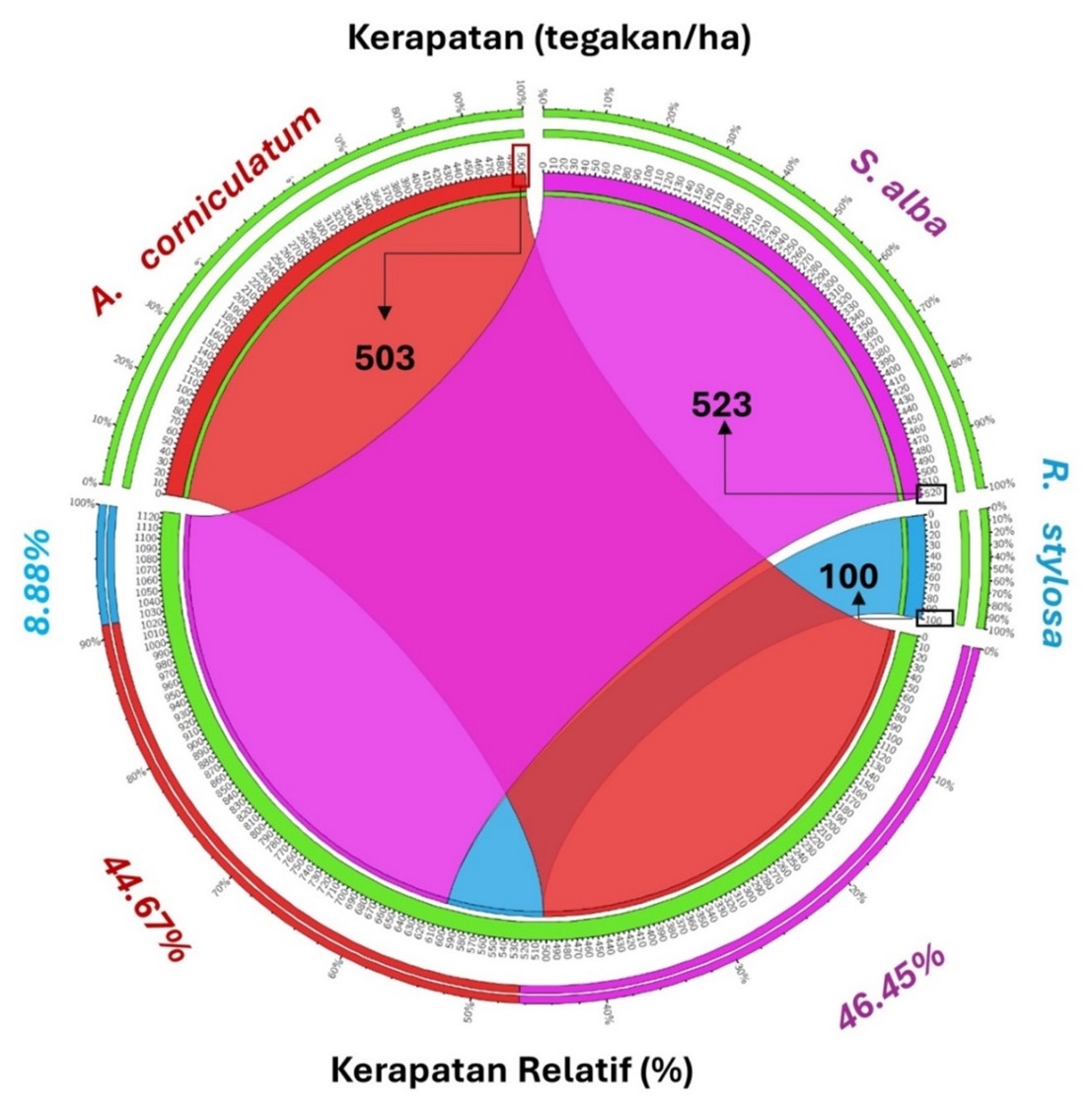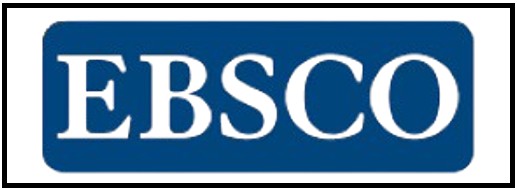Estimation of Mangrove Carbon Standing-stock along the Coast of Kailolo Village, Central Maluku: Implications for Climate Change Mitigation
Abstract
This study aims to estimate the carbon stock and sequestration potential of the mangrove ecosystem along the Hitapory Coast, Kailolo Village, Central Maluku, as a critical step in supporting climate change mitigation efforts. Data collection was conducted at five stations using the quadrat transect method to measure vegetation density, stem diameter, and identify mangrove species. Biomass analysis was performed using allometric equations appropriate for the dominant species. The results indicate a total carbon stock of 330.74 tons C/ha, comprising 227.19 tons C/ha of above-ground carbon (AGC) and 103.55 tons C/ha of below-ground carbon (BGC). The estimated carbon sequestration, expressed in CO₂ equivalents, was 1,212.72 tons CO₂e/ha, with the dominant contribution from Sonneratia alba at 1,187.50 tons CO₂e/ha, while the lowest contribution was from Rhizophora stylosa at 10.76 tons CO₂e/ha. These findings highlight the significant role of the local mangrove ecosystem as an effective carbon sink. Therefore, the conservation and sustainable management of mangroves are essential to support both national and global carbon emission reduction strategies. Furthermore, the study presents an opportunity to develop policies centered on blue carbon trading as an innovative mechanism for climate change mitigation.
References
Alongi, D. M. (2014). Carbon cycling and storage in mangrove forests. Annual review of marine science, 6(1), 195–219. https://doi.org/10.1146/annurev-marine-010213-135020
Bengen, D. G., Yonvitner., & Rahman. (2022). Pedoman Teknis Pengenalan dan Pengelolaan Ekosistem Mangrove. IPB Press; Bogor
Choudhary, B., Dhar, V., & Pawase, A. S. (2024). Blue carbon and the role of mangroves in carbon sequestration: Its mechanisms, estimation, human impacts and conservation strategies for economic incentives. Journal of Sea Research, 199, 102504. https://doi.org/10.1016/j.seares.2024.102504
Clough, B. F., & Scott, K. (1989). Allometric relationships for estimating above-ground biomass in six mangrove species. Forest ecology and management, 27(2),117–127. https://doi.org/10.1016/0378-1127(89)90034-0
Comley, B. W. T., & McGuinness, K. A. (2005). Above-and below-ground biomass, and allometry, of four common northern Australian mangroves. Australian Journal of Botany, 53(5), 431–436. https://doi.org/10.1071/BT04162
Damastuti, E., van Wesenbeeck, B. K., Leemans, R., de Groot, R. S., & Silvius, M. J. (2023). Effectiveness of community-based mangrove management for coastal protection: A case study from Central Java, Indonesia. Ocean & Coastal Management, 238, 106498. https://doi.org/10.1016/j.ocecoaman.2023.106498
Gevana, D., & Im, S. (2016). Allometric models for Rhizophora stylosa Griff. in dense monoculture plantation in the Philippines. Malaysian Forester, 79(1&2), 39–53.
Handayani, S., Adrianto, L., Bengen, D. G., Nurjaya, I. W., & Wardiatno, Y. (2020). Pemetaan jasa ekosistem mangrove pada wilayah rehabilitasi di Pesisir Sayung, Kabupaten Demak. Jurnal Ilmu Pertanian Indonesia, 25(4), 574–583. https://doi.org/10.18343/jipi.25.4.574
Hapsari, F. N., Maslukah, L., Dharmawan, I. W. E., & Wulandari, S. Y. (2022). Simpanan Karbon Organik Dalam Sedimen Mangrove Terhadap Pasang Surut Di Pulau Bintan. Buletin Oseanografi Marina, 11(1), 86–98. https://doi.org/10.14710/buloma.v11i1.39107
Komiyama, A., Poungparn, S., & Kato, S. (2005). Common allometric equations for estimating the tree weight of mangroves. Journal of tropical ecology, 21(4), 471–477. https://doi.org/10.1017/S0266467405002476
Komiyama, A., Ong, J. E., & Poungparn, S. (2008). Allometry, biomass, and productivity of mangrove forests: A review. Aquatic botany, 89(2), 128–137. https://doi.org/10.1016/j.aquabot.2007.12.006
Kusmana, C., Hidayat, T., Tiryana, T., Rusdiana, O., & Istomo. (2018). Allometric models for above-and below-ground biomass of Sonneratia spp. Global ecology and conservation, 15, e00417. https://doi.org/10.1016/j.gecco.2018.e00417
Latuconsina, A. S., Tuahatu, J. W., & Rahman. (2025). Estimation of Litterfall Production of Sonneratia alba and Its Contribution to Carbon Accumulation in Mangrove Sediments in Kailolo Village, Maluku, Indonesia. Asian Journal of Research in Agriculture and Forestry, 11(1), 214–225. https://doi.org/10.9734/ajraf/2025/v11i1378
Morris, R. L., Fest, B., Stokes, D., Jenkins, C., & Swearer, S. E. (2023). The coastal protection and blue carbon benefits of hybrid mangrove living shorelines. Journal of environmental management, 331, 117310. https://doi.org/10.1016/j.jenvman.2023.117310
Murdiyarso, D., Purbopuspito, J., Kauffman, J. B., Warren, M. W., Sasmito, S. D., Donato, D. C., Manuri, S., Krisnawati, H., Taberima, S & Kurnianto, S. (2015). The potential of Indonesian mangrove forests for global climate change mitigation. Nature Climate Change, 5(12), 1089–1092. https://doi.org/10.1038/nclimate2734
Nordhaus, I., Wolff, M., & Diele, K. (2006). Litter processing and population food intake of the mangrove crab Ucides cordatus in a high intertidal forest in northern Brazil. Estuarine, Coastal and Shelf Science, 67(1-2), 239–250. https://doi.org/10.1016/j.ecss.2005.11.022
Noor, Y.R., Khazali, M., & Suryadiputra, I.N.N. (2006). Panduan Pengenalan Mangrove di Indonesia. Wetlands Internasional Indonesia Programme; Bogor.
Nyangoko, B. P., Berg, H., Mangora, M. M., Shalli, M. S., & Gullström, M. (2022). Local perceptions of changes in mangrove ecosystem services and their implications for livelihoods and management in the Rufiji Delta, Tanzania. Ocean & Coastal Management, 219, 106065. https://doi.org/10.1016/j.ocecoaman.2022.106065
Ong, J. E., Gong, W. K., & Wong, C. H. (2004). Allometry and partitioning of the mangrove, Rhizophora apiculata. Forest Ecology and Management, 188(1-3), 395–408. https://doi.org/10.1016/j.foreco.2003.08.002
Owuor, M. A., Mulwa, R., Otieno, P., Icely, J., & Newton, A. (2019). Valuing mangrove biodiversity and ecosystem services: A deliberative choice experiment in Mida Creek, Kenya. Ecosystem Services, 40, 101040. https://doi.org/10.1016/j.ecoser.2019.101040
Poungparn, S., Komiyama, A., Jintana, V., Piriyayaota, S., Sangtiean, T., Tanapermpool, P., Patanaponpaiboon, P., & Kato, S. (2002). A quantitative analysis on the root system of a mangrove, Xylocarpus granatum Koenig. Tropics, 12(1), 35–42. https://doi.org/10.3759/tropics.12.35
Rahman., Efendi, H., & Rusmana I. (2017). Stock estimation and carbon absorption of mangrove in Tallo River, Makassar. Journal of Forest Science, 11,19–28. https://doi.org/10.22146/jik.24867
Rahman., Yulianda, F., Rusmana, I., & Wardiatno Y. (2019). Production ratio of seedlings and density status of mangrove forests in coastal areas of Indonesia. Advances in Environmental Biology, 13(6), 13–21.
Rahman., Maryono., & Sigiro, O.N. (2023). What is the true carbon fraction of mangrove biomass? Malaysian Journal of Science, 42(2), 1–6. https://doi.org/10.22452/mjs.vol42no2.10
Rahman., Lokollo, F. F., Manuputty, G. D., Hukubun, R. D., Krisye., Maryono., Wawo, M., & Wardiatno Y. (2024a). A review on the biodiversity and conservation of mangrove ecosystems in Indonesia. Biodiversity and Conservation, 33(3), 875–903. https://doi.org/10.1007/s10531-023-02767-9
Rahman., Maryono., Saiful., & Wardiatno, Y. (2024b). Penilaian Jasa Ekosistem Mangrove: Pendekatan Sosial, Ekologi, dan Ekonomi. IPB Press; Bogor
Rahman., Ceantury, A., Tuahatu, J. W., Lokollo, F. F., Supusepa, J., Hulopi, M., Permatahati, Y. I., Lewerissa, A., & Wardiatno, Y. (2024c). Mangrove ecosystems in Southeast Asia region: Mangrove extent, blue carbon potential and CO2 emissions in 1996–2020. Science of the Total Environment, 915, 170052. https://doi.org/10.1016/j.scitotenv.2024.170052
Rahman., Lokollo, F. F., Supesepa, J., Natan, J., Mamesah, J. A., Wawo, M., & Latumahina, F. (2024d). Recruitment Index as a Novel Approach to Assessing the Resilience of Natural Mangrove Ecosystems: A Case Study on the Coast of West Muna Regency. Asian Journal of Fisheries and Aquatic Research, 26(10), 12–23.
Rahman, R., Tuahatu, J. W., & Tuhehay, C. (2024e). Blue Carbon Potential of Mangrove Ecosystem on the Coast of Negeri Waai, Central Maluku Regency. Jurnal Ilmu Kehutanan, 18(1), 7–15. https://doi.org/10.22146/jik.v18i1.8814
Rahman., Amalo, L. F., Putra, M. D., Handayani, L. D. W., Zuhri, M. I., Supardi, H., Alfin, L. M., Bena, A., & Rahman, A. (2024f). Existing and Future Carbon Stock of Mangrove Restoration of the REMAJA PHE ONWJ Program in Mekarpohaci Village, Karawang Regency, Indonesia. Egyptian Journal of Aquatic Biology & Fisheries, 28(6), 29–42. https://doi.org/10.21608/ejabf.2024.391031
Rahman., Lokollo, F. F., Wardiatno, Y., Yulianda, F., Rusmana, I., Bengen, D. G., & Berhitu, P. T. (2025). Pengelolaan Ekosistem Mangrove dan Mitigasi Perubahan Iklim. Mafy Media Literasi Indonesia; Solok.
Sievers, M., Brown, C. J., McGowan, J., Turschwell, M. P., Buelow, C. A., Holgate, B., Pearson, R. M., Adame, M. F., Andradi-Brown, D. A., Arnell, A., Mackey, B. G., zu Ermgassen, P. S. E., Gosling, J., McOwen, C. J., Worthington, T. A., & Connolly, R. M. (2023). Co-occurrence of biodiversity, carbon storage, coastal protection, and fish and invertebrate production to inform global mangrove conservation planning. Science of The Total Environment, 904, 166357. https://doi.org/10.1016/j.scitotenv.2023.166357
Sunkur, R., Kantamaneni, K., Bokhoree, C., & Ravan, S. (2023). Mangroves' role in supporting ecosystem-based techniques to reduce disaster risk and adapt to climate change: A review. Journal of Sea Research, 196, 102449. https://doi.org/10.1016/j.seares.2023.102449
Van Hespen, R., Hu, Z., Borsje, B., De Dominicis, M., Friess, D. A., Jevrejeva, S., Kleinhans, M. G., Maza, M., van Bijsterveldt, C. E. J., der Stocken, T. V., van Wesenbeeck, B., Xie, D., & Bouma, T. J. (2023). Mangrove forests as a nature-based solution for coastal flood protection: Biophysical and ecological considerations. Water Science and Engineering, 16(1), 1–13. https://doi.org/10.1016/j.wse.2022.10.004

Copyright (c) 2025 Naflah Dafi Al-Fiyah Ombi, Rahman Rahman, Juliana Wilmiena Tuahatu

This work is licensed under a Creative Commons Attribution-ShareAlike 4.0 International License.
Copyright on articles was retained by the respective author(s) without restrictions. The author grants the journal its first publication rights with the work simultaneously licensed under the Creative Commons Attribution-ShareAlike 4.0 International (CC BY-SA) license. This means anyone is free to copy, transform, or redistribute articles for any lawful purpose in any medium, provided they give appropriate attribution to the original author(s).














